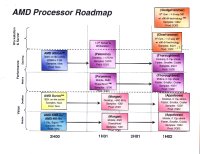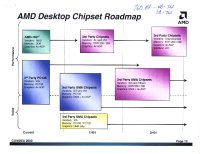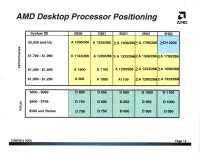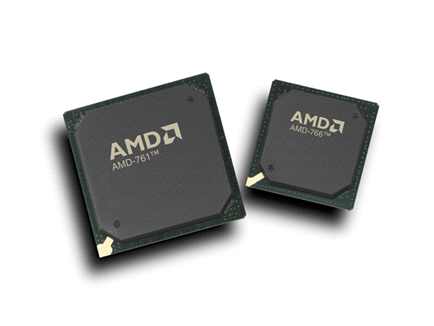 |
2000 AMD Roadmaps
AMD did not have any new product announcements at this years Comdex. Rather they were busy showing us product roadmaps of what we can expect to see in 2000 and beyond. As well they were showing off the upcoming Palomino processor running at 1.5GHz (11 x 133mhz) and a dual Palomino setup running "faster than 1GHz".
I'm sure most people have already seen the 2000-2002 roadmaps, but here they are again for those who have not.

Nothing astounding here, we will begin to see Palomino chips on the market early in 2001. Palomino is a Thunderbird core with enhancements to reduce heat output as well as increase clock speed, but no major changes will be made to the pipeline. Ever since the introduction of the Athlon, traditionally it has been a very hot running processor. AMD representatives we talked to stated that we would be seeing about a 20% decrease in heat production with the Palomino core. With the recently announced 1.2 GHz Thunderbird pumping out around 55watts of heat, AMD is going to need to drop that heat output if they ever expect to hit 1.7GHz.
Absent from this years roadmaps is AMD's high anticipated Mustang CPU. AMD felt that there was not room for two processor cores in the performance desktop and workstation market. Instead the Mustang based Palomino will take the reins with a slightly smaller cache.
Moving further along the performance line, both Palomino solutions migrate to a .13mu fab process and receive more core tweaks to bring along Thoroughbred at about 1.7GHz. One interesting thing AMD was touting is Thoroughbred's small die size of under 100mm^2. Compared to the current thunderbird size of 120mm^2 this translates to faster clock speeds and less heat output.
Finally AMD's long awaited SledgeHammer and ClawHammer make appearances. ClawHammer will be the workstation and small server CPU with under 1Mb of L2 cache. Leaving SledgeHammer to handle the larger server duties with 1-4Mb of L2 cache. We will likely see the first run of Hammer chips on a .18mu fabrication process and then quickly moving over to a .13mu fab. The Hammer family is a marriage between the 32bit Thoroughbred core and AMD's X86-64 architecture, allowing current generation 32bit programs to run fine, and giving those who require additional power to access the 64bit ability of the chip. This means that both ClawHammer and SledgeHammer will have the same 32bit performance as Thoroughbred. The Hammer family is quite impressive being both a current generation 32bit processor, and a next generation 64bit x86 CPU. Intel's only server processor on their roadmap is the IA64 based Itanium CPU and it looks like AMD has hit the nail on the head with the hammer family. Itanium is not compatible with any software currently on the market and will be a huge leap from today’s architectures. Leaving the door wide open for AMD with a good performing, scaleable, 32bit CPU with a large cache.
The Pentium 3 has been the chip of choice for mobile users lately. It simply out muscled AMD's mobile K6-3+ line and has been steadily gaining market share. Mobile Palomino aims to reverse this trend and is being target squarely at the Mobile Pentium 3. We don't know a whole lot about AMD's new chip expect that it will use an enhanced Thunderbird core and feature AMD's PowerNow! technology. We were able to see PowerNow! in action and it does look very promising. The system varies the CPU clockspeed and current draw based on system need. So when you are busy typing a document in word there is no need for full CPU power and the system powers down to around 200Mhz @ 1.4v. Pop in a DVD and the system dynamically adjusts the CPU speed based on the system requirements. We gave the Matrix a quick viewing and the system averaged about 500Mhz @ 1.9v, with complex scenes bringing it up to a full 533MHz @ 2.0v. Note, this was a K6-3+ we saw in action, not a mobile Palomino, but the technology is the same.
On the value side of things, Morgan will take over from both the Duron and K6-3+ lines in the second quarter of 2001. Much like Palomino, Morgan is an enhanced Duron core modified to reduce power draw and heat output. Morgan will take over from the Duron at around 900Mhz and scale to around 1.1Ghz by Q1 2002 at which time Appaloosa will emerge. Once again Appaloosa is a die shrink to .13mu with a few more core tweaks. AMD wasn't too forth coming about the cache sizes of Morgan and Appaloosa, saying they will "likely be similar to today's technology" but as Game PC pointed out in their Duron 800 review, AMD's product identification guide for the Model 3 Durons has a product code for 128K of L2 cache. If this were the case and Morgan does have 128K of L2 cache (256K total) this would be the end of the Celeron and slower Pentium 3's.
As is clearly illustrated in the roadmap the value lines will be introduced about 3 months behind the performance chips, just to better distinguish the two lines. Around the second half of 2001 AMD expects that their entire lineup will have migrated to a 266MHz FSB and DDR memory.
 
On the chipsets side of things not too much new information. VIA's KT266 and AMD's 760 are the chipsets of choice right now. We should begin to see ALi MAGiK based motherboards out shortly, but early reports suggest the MAGiK is having quite a few teething problems. We did not drop by SiS to see how their AMD DDR solution is coming along as we'll have to wait and see what they cook up. The writing up at the top there was just a clarification on the 760 Multi-processor (MP) chipset. 760MP uses the 762 northbridge and the 766 southbridge.

AMD has had a banner year and from what we have seen it looks to be another great year. Steadily ramping clock speeds and die shrinks to .13mu will keep the pressure on Intel. The 760 MP platform looks to be the only choice for next generation multiprocessor workstations and servers until Hammer and Itanium hit the market. DDR SDRAM has been a long time coming and AMD already has the first DDR based systems on the market. Third party makers are also bringing DDR support to Intel's lineup so it will be interesting to see who is able to benefit most. On the mobile side AMD's PowerNow! is such an advancement over Intel's SpeedStep that we are expecting AMD to make large inroads into the mobile market with Palomino and Morgan. But the one key to AMD's continuing success is delivering products on time, if they can stick to the roadmaps the future looks bright.
Andrew Oliver
November 30,2000
Updated Dec 2,2000

|
|